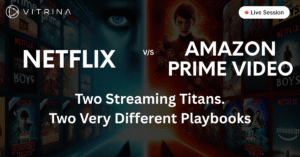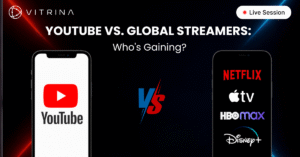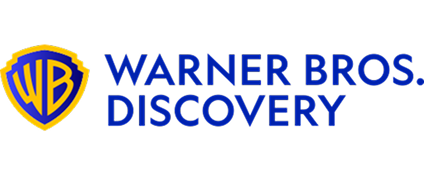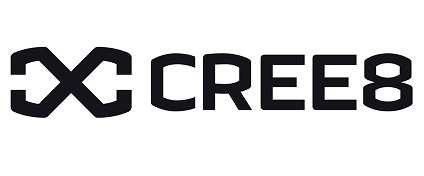Mastering Content Acquisition, Global Strategy, Investment Optimization

Introduction
For media and entertainment (M&E) executives, the process of Content acquisition, global strategy, investment optimization is the single most defining factor of long-term profitability and competitive differentiation.
It is no longer enough to buy content simply to fill a library. Every licensing deal, co-production investment, or pre-buy must be viewed through a financial lens that aggressively seeks maximum return on a finite budget, a concept often referred to as content spend efficiency.
This requires moving beyond siloed, anecdotal sourcing toward a unified, data-driven approach that integrates global strategy with real-time investment optimization intelligence.
The framework presented here addresses the critical executive need for early warning, verified data, and portfolio intelligence necessary to execute a successful global content slate.
Table of content
- The New Era of Content Acquisition, Global Strategy, Investment Optimization
- The Three Pillars of Modern Content Sourcing for the CXO
- The Systemic Challenge: Unverified Project Data and Fragmented Intelligence
- A Data-First Framework for Content Acquisition, Global Strategy, Investment Optimization
- How Vitrina Enables Data-Driven Content Acquisition, Global Strategy, Investment Optimization
- Conclusion: From Fragmentation to Certainty
- Frequently Asked Questions
Key Takeaways
| Core Challenge | The lack of early warning on global projects leads to reactive bidding wars and unverified project data, damaging ROI. |
| Strategic Solution | Implement a predictive sourcing model that uses verified, structured data for early project discovery and precise risk assessment. |
| Vitrina’s Role | Vitrina provides the essential global film and TV project tracking intelligence needed for pre-buys and content acquisition, centralizing fragmented data and verifying key project and executive contacts. |
The New Era of Content Acquisition, Global Strategy, Investment Optimization
The shift in content consumption has irrevocably changed the nature of content acquisition. Historically, acquisition was a reactive process: executives bought completed content or acquired large libraries.
Today, it is a proactive, strategic function designed to fill specific, data-validated gaps in a subscriber-driven global strategy. The pressure to deliver maximum value on C-Spend has made the acquisition executive a primary driver of financial performance.
According to a recent analysis by Omdia, global C-Spend by major streamers is expected to stabilize, meaning the era of unchecked spending is over, putting intense pressure on every deal to show a clear ROI.
This financial discipline demands three fundamental shifts in content acquisition practice:
- From Volume to Precision: Executives must stop acquiring hundreds of titles and instead focus on a small number of high-impact content pre-buys that precisely address portfolio weaknesses in specific genres, territories, or demographics.
- From Relational to Algorithmic: Decisions cannot be based on festival hype or established producer relationships alone. They must be validated by real-time data on the project, the producing company’s execution history, and the track record of the specific executives attached.
- From Local to Global (with Local Expertise): While the goal is a unified global strategy, execution requires specialized, local knowledge for effective international licensing and co-production, necessitating a platform that can map talent and projects across dozens of fragmented international markets.
The Three Pillars of Modern Content Sourcing for the CXO
Effective content sourcing can be distilled into three mutually reinforcing pillars, all driven by the need to maximize ROI.
Pillar 1: Strategic Portfolio Balancing and Content Spend Efficiency
Investment optimization begins with balancing the portfolio. Every acquisition executive must ensure their slate is not over-indexed in one genre or territory.
Portfolio balancing is the systematic process of identifying content deficits using internal subscriber data and then mapping those deficits to available global film and TV project tracking intelligence.
If subscriber data shows a deficit in family animation in LATAM, the executive needs a tool that can instantly filter and verify active co-production and development projects in that specific niche.
This focused approach replaces inefficient broad bidding with precise, data-backed targeting, ensuring every dollar of content spend is highly efficient.
Pillar 2: The Imperative of Early Project Discovery and Pre-Buys
The best way to secure content at the lowest possible price is through early project discovery—identifying a project during its development or pre-production stages before it reaches the open market or a bidding war begins.
Securing content pre-buys is the ultimate form of investment optimization because it allows the buyer to lock in rights or co-production stakes at a lower valuation and to integrate creative notes before full production begins.
However, this is impossible without real-time, verified intelligence on what is in development globally. Relying on slow, annual market events means content is found only when it is already a commodity.
Pillar 3: Managing Cross-Border Risk in International Licensing
International licensing and co-production introduce significant cross-border risks related to intellectual property (IP) compliance, financial transparency, and delivery security. The risk of partnering with a financially unstable or non-compliant producer can wipe out the profitability of a project.
To mitigate this, global strategy must include systematic partner vetting. Executives must look beyond the pitch deck to access verified data on a potential partner’s historical distribution deals, their prior collaborators, and, crucially, the specific executive track records of the people managing the project.
The Systemic Challenge: Unverified Project Data and Fragmented Intelligence
The M&E supply chain is fundamentally fragmented, creating a systemic challenge for Content acquisition, global strategy, investment optimization. This fragmentation stems from:
- The Global Data Maze: Information on film and TV projects in development is scattered across local production registries, trade publications, and regional film commissions. There is no central, unified source. This makes early project discovery slow and expensive.
- The Anecdotal Barrier: Much of the industry still relies on unverified, self-reported data. A production company may claim to be attached to a high-profile project, but without verified metadata linking specific executives and companies to the project’s production stage, the claim remains an assumption—a catastrophic vulnerability in a high-stakes content acquisition deal. The pain of relying on anecdote in high-risk transactions is a key challenge for executives, as discussed in our piece on pain points in cross-border transactions.
- Lack of Executive Intelligence: Executing a global strategy requires knowing who is making the decisions. Without verified, current contact and role information, outreach to potential co-producers or financiers is inefficient, leading to critical delays and missed opportunities.
This environment forces executives to be reactive, often entering content bidding wars that erode all potential investment optimization.
A Data-First Framework for Content Acquisition, Global Strategy, Investment Optimization
To convert a defensive, reactive approach into a predictive, profitable content acquisition engine, M&E executives must adopt a three-phase data-first framework.
Phase 1: Predictive Sourcing, Not Reactive Bidding
The core of this phase is shifting the search focus from content that is available (and expensive) to content that is in development (and affordable). This requires global film and TV project tracking intelligence that provides an early warning signal—often 12 to 18 months before a project is marketed at a major event.
This predictive sourcing model enables the executive to approach a producer with an offer for a content pre-buy before their competition is even aware the project exists, securing better terms and ensuring an optimal strategic fit.
Phase 2: Vetting Beyond the Pitch
Vetting is the cornerstone of investment optimization. Before signing any international licensing or co-production deal, the executive must verify three core data sets:
- Project Velocity: Is the company actually executing the projects they claim? How many projects are currently in development versus production?
- Executive Stability: Are the key creative and financial decision-makers attached to the project still at the company? High executive turnover is a major risk indicator.
- Collaborative History: Who has this company successfully completed projects with before? This provides an objective measure of reliability and cultural fit, key elements for effective content sourcing.
Phase 3: Optimizing the Investment by Reducing Risk
True investment optimization means reducing financial and reputational risk as much as increasing revenue. This involves using M&E competitive intelligence to understand the content landscape.
For instance, before committing funds to a genre, an executive must verify the current slate of competitors’ content pre-buys to prevent immediate market saturation.
Furthermore, reducing risk means ensuring the acquired content uses pre-vetted, high-compliance vendors in the supply chain, a factor often overlooked in the rush to secure the initial deal. Our solutions page provides further context on optimizing the content supply chain .
How Vitrina Enables Data-Driven Content Acquisition, Global Strategy, Investment Optimization
Vitrina is the centralized intelligence layer built to execute this data-first framework. It solves the systemic problem of fragmented, unverified data that plagues modern content acquisition.
Vitrina’s platform allows M&E executives to transform global strategy from a theoretical goal into an actionable plan for investment optimization.
Vitrina’s core capabilities directly address the executive pain points in content sourcing:
- Early Project Discovery and Tracking: The Film+TV Projects Tracker is Vitrina’s proprietary database of over 250,000 film and TV projects globally, tracked from development through release. This enables early project discovery, allowing executives to filter projects by stage, genre, budget, and territory, securing the competitive edge needed for superior content pre-buys.
- Verified Executive and Company Profiles: Vitrina provides intelligence on over 100,000 companies and three million industry executives. This allows the executive to move past anecdotal claims and unverified project data to verify executive track records, company ownership, and actual collaborative history, reducing the risk in international licensing significantly. The platform’s ability to link projects to the companies and executives working on them makes vetting precise and systematic.
- Supply Chain and Competitive Mapping: By aggregating structured M&E metadata, Vitrina provides a clear map of the competitive landscape, showing what content is being produced, by whom, and at what stage. This intelligence is crucial for effective M&E competitive intelligence and strategic content spend efficiency.
The result is a streamlined, de-risked approach to content acquisition that is predictive, precise, and maximizes the return on every dollar of investment.
Conclusion: From Fragmentation to Certainty
The complexity of modern Content acquisition, global strategy, investment optimization demands a new operating model. The executive challenge is to transition from relying on fragmented information and personal relationships to adopting a systematic, data-verified intelligence platform.
Those who successfully integrate real-time global film and TV project tracking intelligence into their content sourcing processes will secure the most valuable content at the best prices, ensuring maximum content spend efficiency and competitive advantage.
The future of M&E profitability belongs to the executive who masters the intelligence, not the bidding war.
Frequently Asked Questions
Executives can improve pre-buy ROI accuracy by integrating verified, real-time data on the project’s production stage and the producer’s historical completion rate into their valuation models. Furthermore, tracking M&E competitive intelligence on similar upcoming content helps refine risk factors and market potential, making investment optimization more reliable.
The primary risks include high exposure to unverified project data, leading to financial loss or project delays; increased vulnerability to IP theft and security breaches due to unvetted partners; and critical time loss due to inefficient manual early project discovery across dozens of fragmented international markets.
Early project discovery allows executives to identify and commit to content that strategically fills specific portfolio gaps—by genre, territory, or target demographic—before the content becomes part of a competitive market bidding process. This proactive approach ensures content is acquired for strategic need, not market reaction, supporting effective portfolio balancing.
Critical data points for vetting international content sourcing partners include their verified history of completed distribution deals in the target market, their operational compliance (e.g., TPN security status for digital delivery), and the track record and tenure of the specific executives responsible for managing the license.















































